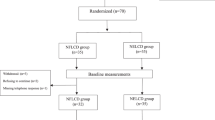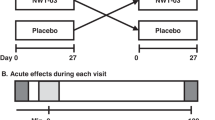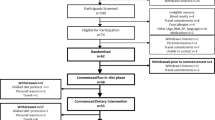Abstract
Objective:
To measure effects of fish oil supplements on lipoprotein subclasses by nuclear magnetic resonance (NMR) in subjects with type II diabetes and relate them to insulin sensitivity.
Design:
Two-armed, parallel, placebo-controlled, randomized.
Subjects:
Normotriglyceridemic subjects with type II diabetes without insulin treatment were given either fish oil (n=12, median intake 5.9 g/day total n-3 fatty acids (FA) (1.8 g 20:5n-3, 3.0 g 22:6n-3)) or corn oil (n=14, 8.5 g/day 18:2n-6 FA).
Methods:
Size and concentration of lipoproteins subclasses were measured by NMR, insulin sensitivity by hyperinsulinemic, isoglycemic clamps.
Results:
After 9 weeks, there were differences between those treated with fish and corn oil with respect to very low-density lipoprotein (VLDL) size (median −15 vs +0.6%, P=0.001), particle concentrations of large VLDL (−99 vs −4.1%, P=0.041) and small high-density lipoprotein (HDL) (−12 vs +10%, P=0.051). Compared with corn oil fish oil tended to increase HDL size and small low-density lipoprotein (LDL) concentration (P=0.063 and 0.068, respectively, for differences between groups). There was no effect on oxidized LDL. Insulin sensitivity (glucose utilization) decreased in the fish oil group compared with the corn oil group (P=0.049). The decrease in insulin sensitivity did not correlate with the effects on lipoprotein subclasses.
Conclusions:
A high intake of n-3 FA exerts effects on several lipoprotein subclasses without obvious influence from changes in insulin sensitivity.
Sponsorship:
Norwegian Foundation for Health and Rehabilitation, Peter Möller AS, Novo Nordisk, Abbot Norge AS, The Norwegian Diabetes Association.
This is a preview of subscription content, access via your institution
Access options
Subscribe to this journal
Receive 12 print issues and online access
$259.00 per year
only $21.58 per issue
Buy this article
- Purchase on Springer Link
- Instant access to full article PDF
Prices may be subject to local taxes which are calculated during checkout




Similar content being viewed by others
References
Baumstark MW, Frey I, Berg A, Keul J (1992). Influence of n-3 fatty acids from fish oils on concentration of high- and low-density lipoprotein subfractions and their lipid and apolipoprotein composition. Clin Biochem 25, 338–340.
Connor WE (2000). Importance of n-3 fatty acids in health and disease. Am J Clin Nutr 71, 171S–175S.
Davis TM, Wright AD, Mehta ZM, Cull CA, Stratton IM, Bottazzo GF et al. (2005). Islet autoantibodies in clinically diagnosed type 2 diabetes: prevalence and relationship with metabolic control (UKPDS 70). Diabetologia 48, 695–702.
Festa A, Williams K, Hanley AJ, Otvos JD, Goff DC, Wagenknecht LE et al. (2005). Nuclear magnetic resonance lipoprotein abnormalities in prediabetic subjects in the Insulin Resistance Atherosclerosis Study. Circulation 111, 3465–3472.
Freedman DS, Otvos JD, Jeyarajah EJ, Barboriak JJ, Anderson AJ, Walker JA (1998). Relation of lipoprotein subclasses as measured by proton nuclear magnetic resonance spectroscopy to coronary artery disease. Arterioscler Thromb Vasc Biol 18, 1046–1053.
Friedewald WT, Levy RI, Fredrickson DS (1972). Estimation of the concentration of low-density lipoprotein cholesterol in plasma, without use of the preparative ultracentrifuge. Clin Chem 18, 499–502.
Garvey WT, Kwon S, Zheng D, Shaughnessy S, Wallace P, Hutto A et al. (2003). Effects of insulin resistance and type 2 diabetes on lipoprotein subclass particle size and concentration determined by nuclear magnetic resonance. Diabetes 52, 453–462.
Goff Jr DC, D'Agostino Jr RB, Haffner SM, Otvos JD (2005). Insulin resistance and adiposity influence lipoprotein size and subclass concentrations. Results from the Insulin Resistance Atherosclerosis Study. Metabolism 54, 264–270.
Harris WS (1997). n-3 fatty acids and serum lipoproteins: human studies. Am J Clin Nutr 65, 1645S–1654S.
Harris WS (2004). Fish oil supplementation: evidence for health benefits. Cleve Clin J Med 71, 208.
Harris WS, Connor WE, McMurry MP (1983). The comparative reductions of the plasma lipids and lipoproteins by dietary polyunsaturated fats: salmon oil versus vegetable oils. Metabolism 32, 179–184.
Holvoet P, Mertens A, Verhamme P, Bogaerts K, Beyens G, Verhaeghe R et al. (2001). Circulating oxidized LDL is a useful marker for identifying patients with coronary artery disease. Arterioscler Thromb Vasc Biol 21, 844–848.
Holvoet P, Vanhaecke J, Janssens S, Van de WF, Collen D (1998). Oxidized LDL and malondialdehyde-modified LDL in patients with acute coronary syndromes and stable coronary artery disease. Circulation 98, 1487–1494.
Jensen CV (1991). A computer program for randomizing patients with near-even distribution of important parameters. Comput Biomed Res 24, 429–434.
Julius U (2003). Influence of plasma free fatty acids on lipoprotein synthesis and diabetic dyslipidemia. Exp Clin Endocrinol Diabetes 111, 246–250.
Luo J, Rizkalla SW, Vidal H, Oppert JM, Colas C, Boussairi A et al. (1998). Moderate intake of n-3 fatty acids for 2 months has no detrimental effect on glucose metabolism and could ameliorate the lipid profile in type 2 diabetic men. Results of a controlled study. Diabetes Care 21, 717–724.
Malasanos TH, Stacpoole PW (1991). Biological effects of omega-3 fatty acids in diabetes mellitus. Diabetes Care 14, 1160–1179.
Meisinger C, Baumert J, Khuseyinova N, Loewel H, Koenig W (2005). Plasma oxidized low-density lipoprotein, a strong predictor for acute coronary heart disease events in apparently healthy, middle-aged men from the general population. Circulation 112, 651–657.
Minihane AM, Khan S, Leigh-Firbank EC, Talmud P, Wright JW, Murphy MC et al. (2000). ApoE polymorphism and fish oil supplementation in subjects with an atherogenic lipoprotein phenotype. Arterioscler Thromb Vasc Biol 20, 1990–1997.
Montori VM, Farmer A, Wollan PC, Dinneen SF (2000). Fish oil supplementation in type 2 diabetes: a quantitative systematic review. Diabetes Care 23, 1407–1415.
Mori TA, Bao DQ, Burke V, Puddey IB, Watts GF, Beilin LJ (1999). Dietary fish as a major component of a weight-loss diet: effect on serum lipids, glucose, and insulin metabolism in overweight hypertensive subjects. Am J Clin Nutr 70 (5), 817–825.
Mostad IL, Bjerve KS, Bjørgaas MR, Lydersen S, Grill V (2006). Effects of n-3 fatty acids in subjects with type 2 diabetes: reduction of insulin sensitivity and time-dependent alteration from carbohydrate to fat oxidation. Am J Clin Nutr 84, 540–550.
Nestel PJ (2000). Fish oil and cardiovascular disease: lipids and arterial function. Am J Clin Nutr 71, 228S–231S.
Otvos JD (2002). Measurement of lipoprotein subclass profiles by nuclear magnetic resonance spectroscopy. Clin Lab 48, 171–180.
Otvos JD, Jeyarajah EJ, Bennett DW, Krauss RM (1992). Development of a proton nuclear magnetic resonance spectroscopic method for determining plasma lipoprotein concentrations and subspecies distributions from a single, rapid measurement. Clin Chem 38, 1632–1638.
Packard CJ (2006). Small dense low-density lipoprotein and its role as an independent predictor of cardiovascular disease. Curr Opin Lipidol 17, 412–417.
Patti L, Maffettone A, Iovine C, Marino LD, Annuzzi G, Riccardi G et al. (1999). Long-term effects of fish oil on lipoprotein subfractions and low density lipoprotein size in non-insulin-dependent diabetic patients with hypertriglyceridemia. Atherosclerosis 146, 361–367.
Petersen M, Dyrby M, Toubro S, Engelsen SB, Nørgaard L, Pedersen HT et al. (2005). Quantification of lipoprotein subclasses by proton nuclear magnetic resonance-based partial least-squares regression models. Clin Chem 51, 1457–1461.
Petersen M, Pedersen H, Major-Pedersen A, Jensen T, Marckmann P (2002). Effect of fish oil versus corn oil supplementation on LDL and HDL subclasses in type 2 diabetic patients. Diabetes Care 25, 1704–1708.
Pocock SJ, Simon R (1975). Sequential treatment assignment with balancing for prognostic factors in the controlled clinical trial. Biometrics 31, 103–115.
Rimestad AH, Blaker B, Flåten A-M, Nordbotten A (1995). Den store matvaretabellen (The Norwegian Food Table). In norwegian. Universitetsforlaget: Oslo.
Scheffer PG, Bos G, Volwater HG, Dekker JM, Heine RJ, Teerlink T (2003). Associations of LDL size with in vitro oxidizability and plasma levels of in vivo oxidized LDL in type 2 diabetic patients. Diabet Med 20, 563–567.
Steinmetz A (2003). Treatment of diabetic dyslipoproteinemia. Exp Clin Endocrinol Diabetes 111, 239–245.
Sullivan DR, Sanders TA, Trayner IM, Thompson GR (1986). Paradoxical elevation of LDL apoprotein B levels in hypertriglyceridaemic patients and normal subjects ingesting fish oil. Atherosclerosis 61, 129–134.
Suzukawa M, Abbey M, Howe PR, Nestel PJ (1995). Effects of fish oil fatty acids on low density lipoprotein size, oxidizability, and uptake by macrophages. J Lipid Res 36, 473–484.
Syvänne M, Taskinen MR (1997). Lipids and lipoproteins as coronary risk factors in non-insulin-dependent diabetes mellitus. Lancet 350 (Suppl 1), SI20–SI23.
Vickers AJ, Altman DG (2001). Statistics notes: analysing controlled trials with baseline and follow up measurements. BMJ 323, 1123–1124.
Wilkinson P, Leach C, Ah-Sing EE, Hussain N, Miller GJ, Millward DJ et al. (2005). Influence of alpha-linolenic acid and fish-oil on markers of cardiovascular risk in subjects with an atherogenic lipoprotein phenotype. Atherosclerosis 181, 115–124.
Witte DR, Taskinen MR, Perttunen-Nio H, Van TA, Livingstone S, Colhoun HM (2004). Study of agreement between LDL size as measured by nuclear magnetic resonance and gradient gel electrophoresis. J Lipid Res 45, 1069–1076.
Woodman RJ, Mori TA, Burke V, Puddey IB, Watts GF, Beilin LJ (2002). Effects of purified eicosapentaenoic and docosahexaenoic acids on glycemic control, blood pressure, and serum lipids in type 2 diabetic patients with treated hypertension. Am J Clin Nutr 76, 1007–1015.
Yu HH, Ginsburg GS, O'Toole ML, Otvos JD, Douglas PS, Rifai N (1999). Acute changes in serum lipids and lipoprotein subclasses in triathletes as assessed by proton nuclear magnetic resonance spectroscopy. Arterioscler Thromb Vasc Biol 19, 1945–1949.
Acknowledgements
We thank the subjects who participated in the study. We also thank Ingrid Hals Jørgensen for assistance with oxidized LDL analyses, and the medical and secretarial staff at the Division of Endocrinology and the staff at the Department of Medical Biochemistry, St Olavs Hospital for help in various ways.
Author information
Authors and Affiliations
Corresponding author
Additional information
Contributors: VG initiated and designed the study together with ILM. VG took part in data analyses and paper writing. ILM was responsible for and participated in all aspects of the study including planning and designing, preparing samples for NMR analyses, performing clamps as well as the major part of paper writing. SL and ILM carried out the statistical analyses. KSB was responsible for evaluating many of the laboratory analyses and advising on study design and participating in paper writing. None of the contributors had a conflict of interest.
Rights and permissions
About this article
Cite this article
Mostad, I., Bjerve, K., Lydersen, S. et al. Effects of marine n-3 fatty acid supplementation on lipoprotein subclasses measured by nuclear magnetic resonance in subjects with type II diabetes. Eur J Clin Nutr 62, 419–429 (2008). https://doi.org/10.1038/sj.ejcn.1602703
Received:
Revised:
Accepted:
Published:
Issue Date:
DOI: https://doi.org/10.1038/sj.ejcn.1602703
Keywords
This article is cited by
-
Effect of diets rich in either saturated fat or n-6 polyunsaturated fatty acids and supplemented with long-chain n-3 polyunsaturated fatty acids on plasma lipoprotein profiles
European Journal of Clinical Nutrition (2017)



